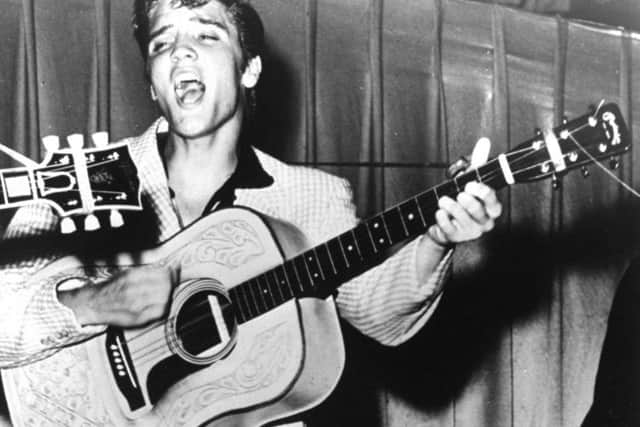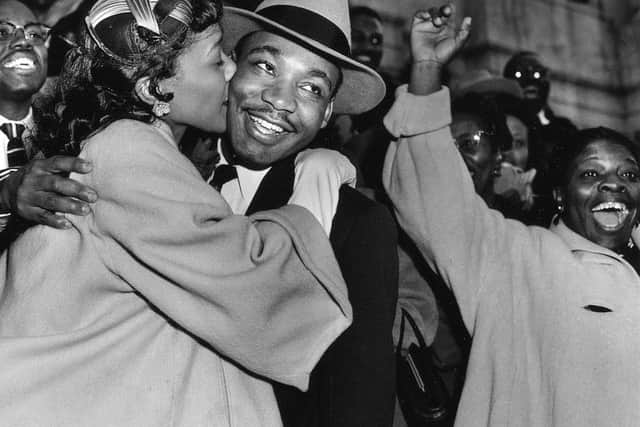1956: A year of revolution, protest and rock '˜n roll


IN an editorial on New Year’s Day in 1956, the New York Times proclaimed: “We can say this year more than ever before that the future depends on the courage, the resolution and the energy of the democratic man.”
The tumultuous events that unfolded during the ensuing 12 months proved these words to be more prescient than anyone could have realised at the time.
Advertisement
Hide AdAdvertisement
Hide AdAll years are memorable for one reason or another, but 1956 was to prove one of the most seismic of the 20th Century. All over the world ordinary people spoke out, filled streets and city squares and in some cases took up arms in a bid to claim the freedoms for which so many had died during the Second World War.


It’s a year that is the focus of a new book by Dr Simon Hall, a senior lecturer in American history at the University of Leeds. 1956 - The World In Revolt, provides a vivid, sweeping view of events, the reverberations of which can still be felt today.
But what caused him to focus on this particular year? “The Fifties suffer in comparison a bit amid all the drama of the Second World War and the 1960s, they’re seen as a kind of grey decade and one of conformity. But I became interested in the growing rebellions and confrontations, the birth of rock ‘n’ roll and the growing Civil Rights Movement. I started noticing a lot of things happening in 1956 and I thought it would make an interesting subject for a book,” he says.
“There’s a generational shift taking place, because the origins of a lot of what was going on in the 60s can be traced back to the mid-50s. Some of the things that happen in 1956 have a domino effect, people see what’s happening in another country and react to it.”
Advertisement
Hide AdAdvertisement
Hide AdDr Hall believes the rising tide of protest dates back to the end of the Second World War. “A lot of bold claims had been made around what the post-war world would be like with greater freedom and greater democracy and a lot of those hopes had been frustrated,” he says.


“Britain and France were very reluctant to let go of their empires, Moscow essentially imposed satellite states in Eastern Europe. For African-Americans in the deep south there was very little change in terms of greater equality, and you get a sense of these frustrations reaching breaking point and I don’t think it’s a coincidence that it’s ten years after the war.”
For Britain, 1956 is synonymous with Suez. The crisis started when Egypt’s President Nasser nationalised the Suez Canal, run by a company jointly owned by Britain and France. The two countries saw it as an attack on their status and wanted to overthrow Nasser. A secret plan was hatched that involved the Israelis pretending to invade Egypt, which was then used as a pretext to intervene.
However, the move backfired spectacularly. “It caused outrage around the world and it annoyed the Americans.” It also divided public opinion in Britain. “There were demonstrations in a number of cities including Leeds, led by students and members of Leeds University’s Arab Society. They marched from the university and down through the city centre.”
Advertisement
Hide AdAdvertisement
Hide AdInternational pressure forced Britain and France into a humiliating climb down and Dr Hall believes it was a pivotal moment in our post-war history. “Suez is important because it encourages the pace of decolonisation elsewhere in the empire.


“It makes it clear that Britain is no longer the power it once was and shows that the empire is coming to an end. Postwar planners in Whitehall thought they could stave off the independence of these countries for another 20 or 30 years, and in the end most of it happens within a decade of the Suez Crisis.”
There wasn’t just political unrest, cultural change was also afoot. This was the year Ted Hughes married Sylvia Plath and Arthur Miller tied the knot with Marilyn Monroe. It saw the first performance of John Osborne’s ground-breaking play Look Back in Anger and the publication of Allen Ginsberg’s anthemic poem, Howl.
The world was also waking up to a new phenomena called ‘youth culture’ whose beating heart was a thing called rock ‘n’ roll. Elvis Presley was its virile embodiment and his first appearance on The Ed Sullivan Show on September 9, attracted a staggering 90 per cent of America’s TV audience.
Advertisement
Hide AdAdvertisement
Hide AdIt’s hard to believe today, but in the mid-50s rock ‘n’ roll was seen by some as a threat to society. “There were a lot of fears about rock ‘n’ roll in the United States, particularly among white southerners who looked at young white teenagers going to these concerts by African-American musicians and were worried about mixed audiences,” says Dr Hall.


“Some of those fears were even seen over here. One newspaper had a line questioning whether rock ‘n’ roll was ‘the Negroes revenge.’” Such language is shocking to us today but it highlighted the underlying social tensions of the time. The film Rock Around the Clock was banned by 80 local councils, including Bradford, amid fears it encouraged teenage delinquency and social disorder.
For many people, though, the Hungarian Revolution was the defining moment of 1956. Hungary had been controlled since 1945 by the Soviet Union, but Nikita Khrushchev’s speech denouncing Stalin kindled hopes of greater freedoms in Eastern Bloc countries. “There’s an uprising in Poznan in June and a massive protest in Warsaw and that is seized on by people in Hungary who take to the streets in solidarity with the Poles.”
On October 23, the Hungarians rose up initially repelling the Soviets. However, ten days later Khrushchev sent in waves of tanks and brutally crushed the revolt. The world watched in horror as more than 4,000 Hungarians were killed and a further 200,000 fled the country - with more than 20,000 refugees arriving in Britain.
Advertisement
Hide AdAdvertisement
Hide AdAt the time, The Yorkshire Post reported that 400 Leeds University students marched in silence through city centre “in mourning for the people of Hungary”. A relief fund was set up in the city that raised more than £6,700, while places like Halifax, Ilkley, Harrogate and Bridlington also helped raise money.
“The Hungarian Revolution captured the imagination of much of the world but it was crushed by the Red Army,” says Dr Hall. “In Algeria there was terrible violence on both sides in that struggle and in South Africa most of the leaders of the freedom struggle, including Nelson Mandela and Walter Sisulu, were put on trial for treason.”
There were racial tensions in the US, too. “The Montgomerey Bus Boycott was a key moment in the Civil Rights Movement but there were still lots of incidents where segregationists were successful in preventing African Americans from attending integrated schools, so it’s a story of clashes with both victories and defeats,” he says.
“At the end of the year, Martin Luther King gave a speech in which he told a massive crowd of supporters that they were living at the dawning of a new age and a momentous period in human history.
Advertisement
Hide AdAdvertisement
Hide Ad“He talked about the people who were demanding greater freedom and trying to create a better, fairer world, and the guardians of the old order who, he said, were always on hand with their oxygen tents to keep the status quo alive.
“So 1956 wasn’t just about people uprising, it was also about those in power attempting to crush it.”
1956 - The World In Revolt, published by Faber & Faber, is out now priced £20. Simon Hall is appearing at Waterstones in Leeds tomorrow at 6.30pm. The event is free but places must be reserved. Call 0113 244 4588.
1956: What has been the legacy?
It’s one of the defining moments in 20th Century history and Dr Hall says the legacy of 1956 can still be seen today.
Advertisement
Hide AdAdvertisement
Hide Ad“In some ways you look back and see how different things are compared to today. The Soviet Union has been consigned to history, even communism itself has disappeared.
“But then you look at headlines around police brutality in the US and the shooting of young black men, if you look at the debates in Britain around what its place should be in Europe, you look at the worries in Kiev and Riga about Russia’s recent expansionist moves, there are parallels and some of today’s problems can be related back to some extent to the way the end of empires was handled.”